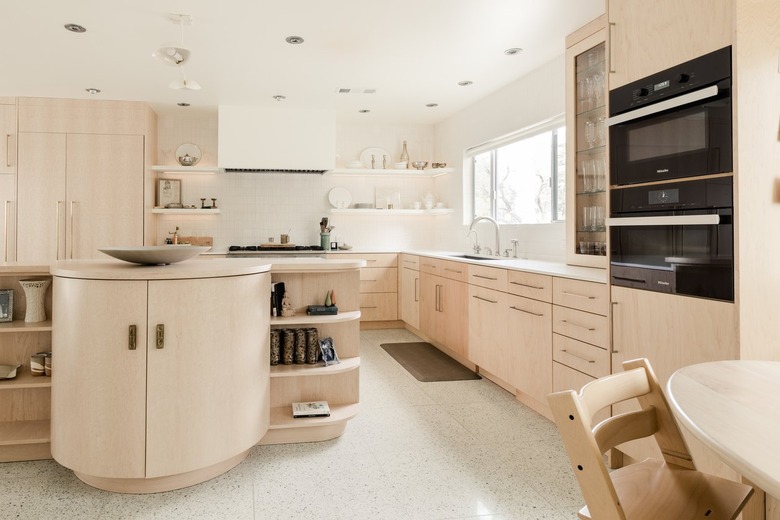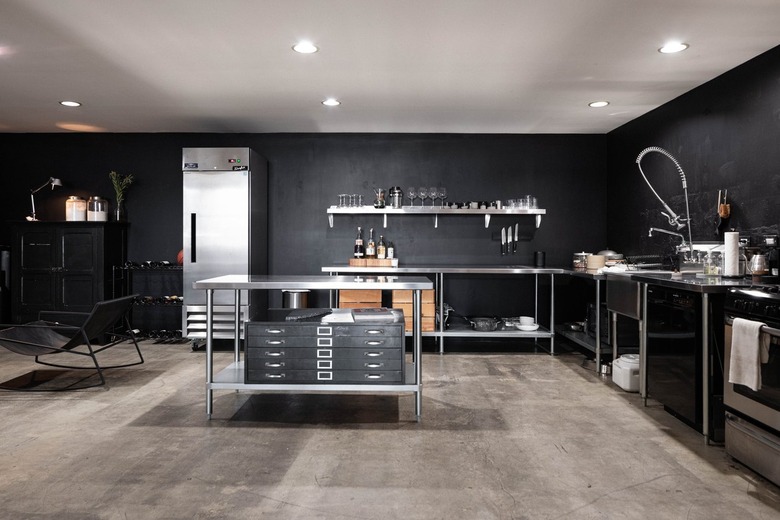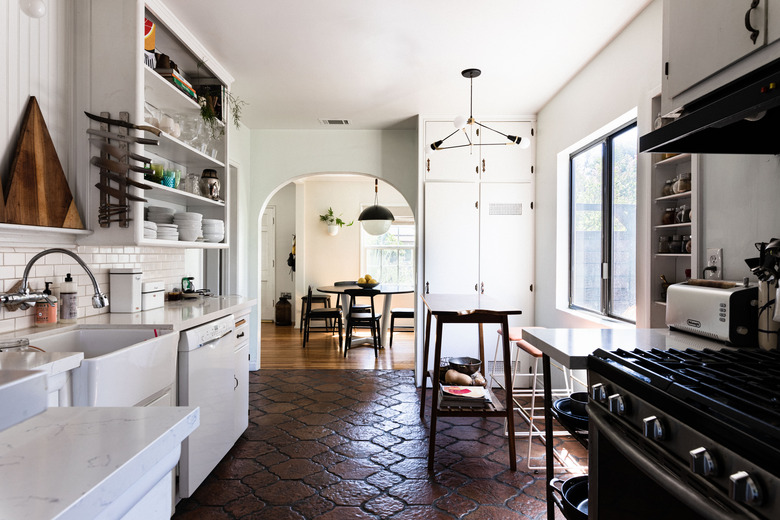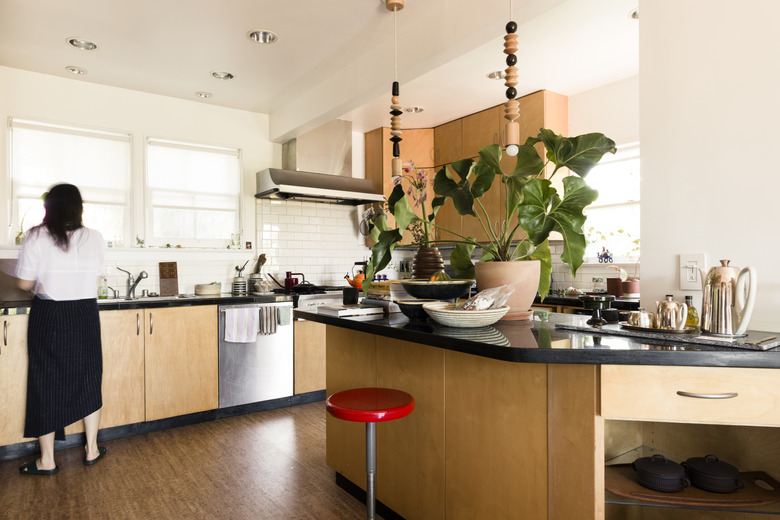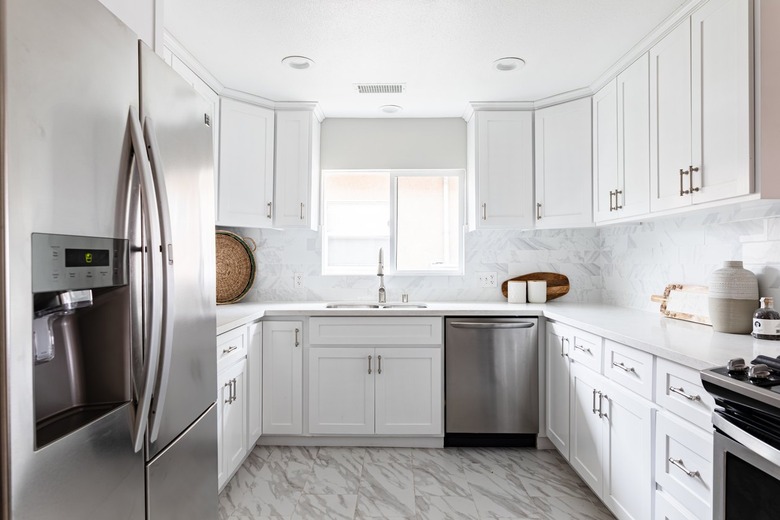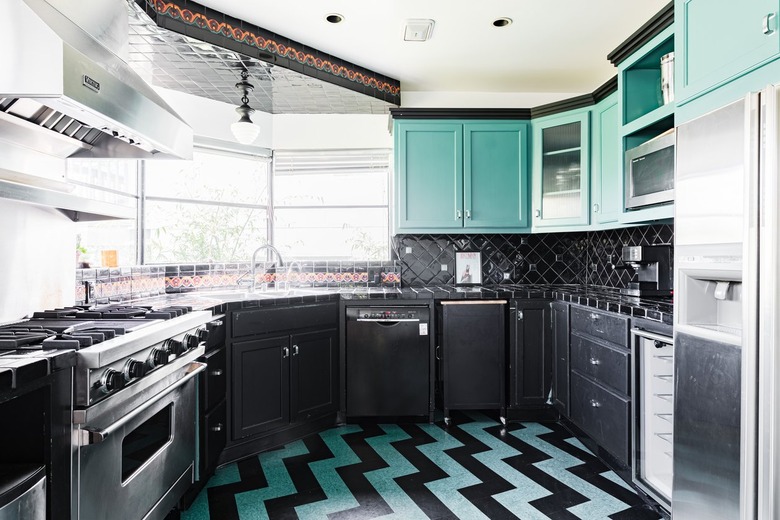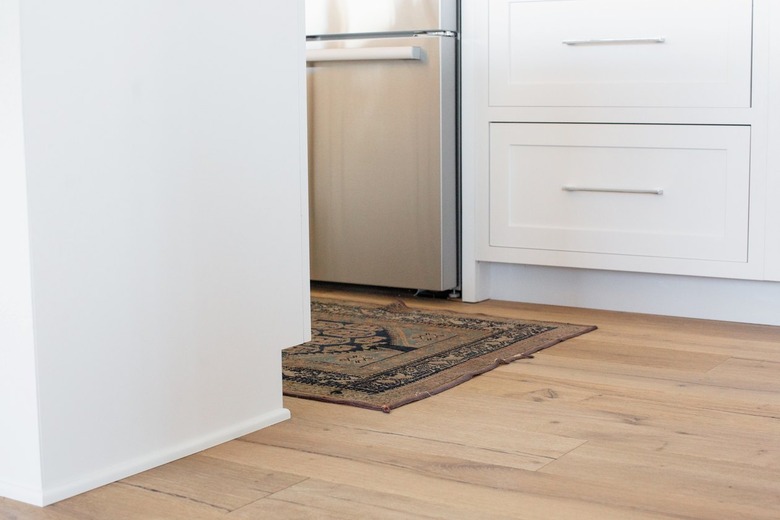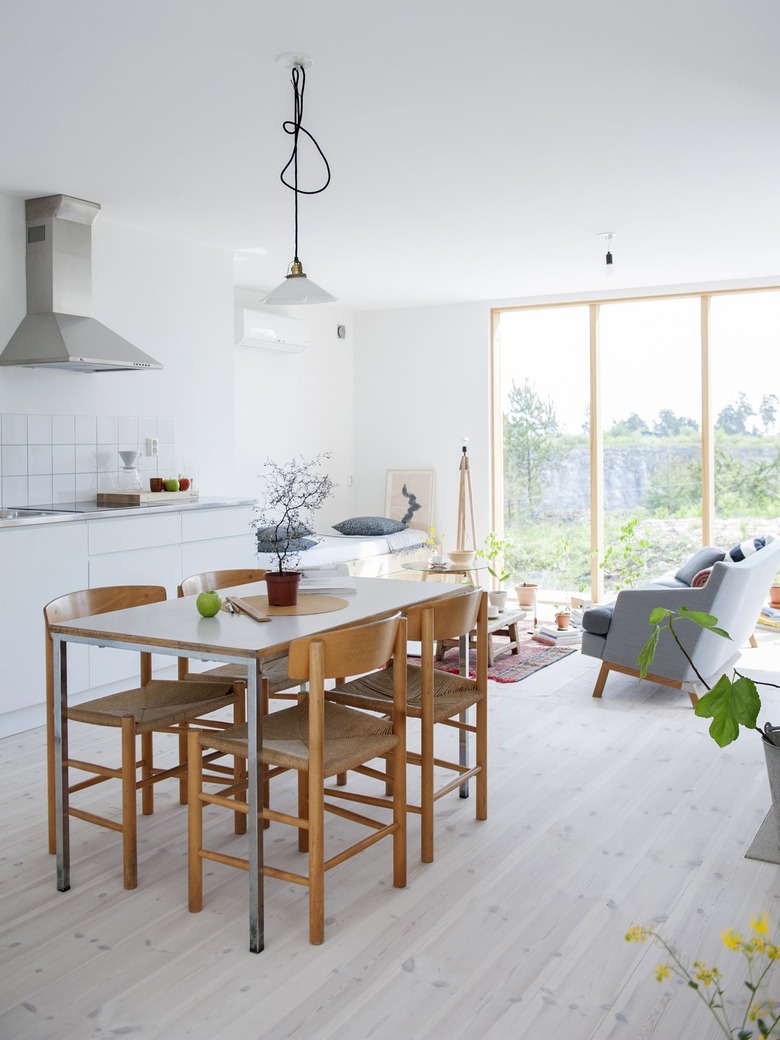Kitchen Flooring: What You Need To Know
We may receive a commission on purchases made from links.
Choosing kitchen flooring can be both the easiest and the hardest flooring decision you'll make for anywhere in the house. It's the easiest because you can quickly rule out about half of the common flooring materials as being unsuitable for this busy, messy room. It's the hardest because no other room demands more from its flooring in terms of performance, durability and, for many people, looks.
Above all, kitchen flooring must be hard wearing and easy to clean, and unless you like a lot of maintenance, your kitchen floor should also be highly moisture resistant. That probably leaves you with fewer good flooring options than you might have guessed. Don't worry — narrowing your choices is a good thing, and it helps you focus on other decision factors like cost, ease of installation and even eco-friendliness.
The Best and Worst Kitchen Flooring
The Best and Worst Kitchen Flooring
The hands-down best material for kitchen floors is tile, either glazed ceramic or porcelain. Tile offers the greatest durability and moisture resistance of all flooring types, and you simply can't hurt it with frequent cleaning, which is something that all kitchens need.
The next-best materials are luxury vinyl and sheet vinyl followed by vinyl or linoleum tile. All of these are hard wearing and easy to clean and maintain, but only luxury vinyl and sheet vinyl can rightly be called "waterproof," as tiles have some vulnerability to moisture due to their numerous seams.
The worst kitchen flooring option is easy to guess: carpet. Spills of any kind are difficult if not impossible to remove from carpet, and if you're not spilling stuff in your kitchen, you're probably on vacation. The only carpeting that makes any sense at all in the kitchen is modular carpet tiles, which can be lifted from the floor and washed in the sink or bathtub if necessary.
Not-So-Good Kitchen Flooring
Not-So-Good Kitchen Flooring
Most people recognize the drawbacks of carpet in the kitchen, but there's another category of flooring that should give you pause even though countless sources will recommend it. This category includes most types of flooring designed for "floating floor" installation, particularly materials made with fiberboard cores. That includes all laminate flooring as well as most cork, linoleum and vinyl in click-together or interlocking form.
The problem with floors made for floating installation lies in the fiberboard that's used for the base layer and the interlocking edges of the flooring. Fiberboard (such as HDF and MDF) is highly susceptible to moisture damage; it swells and eventually crumbles after getting wet. While the top layer of laminate (or cork, vinyl, etc.) flooring is moisture resistant, all floating floors have numerous seams, and those seams cannot be sealed against moisture no matter what flooring manufacturers claim.
If water is allowed to sit on the floor, whether it's from a set-aside mop bucket, a leaky dishwasher door or an errant ice cube that melted, it can soak into a seam and damage the flooring permanently. Damaged fiberboard cannot be fixed.
Tile Flooring in the Kitchen
Tile Flooring in the Kitchen
Tile is the undisputed king of kitchen flooring chiefly because of its durability. It's as close as flooring comes to being bulletproof. It can't be damaged by water or virtually any cleaner, and it's highly resistant to stains. You really can't stain glazed ceramic or porcelain tile, and even the dreaded grout lines between tiles are generally stain resistant if they are properly sealed. If not, grout will stain like crazy because it's basically solidified sand.
However, not all tile is equally durable and trouble-free. Natural stone tile is much fussier and more high-maintenance than ceramic and porcelain. Stone must be sealed (both the tile and the grout) for stain resistance, and the porous material can be damaged by acids and harsh cleaners. The only reason to consider stone over ceramic or porcelain is its natural beauty.
Tile comes in a seemingly endless range of colors and styles, from tiny "penny" tiles to large-format slabs that can cover several square feet with one tile. As noted by the Ceramic Tile Education Foundation, floor tile should be installed over cement board (or a similar tile backer), which adds about 3/8 inch to 5/8 inch of thickness to the floor overall. Installing most types of tile is a reasonable job for many do-it-yourselfers, but some stone tile, rectified tile (with ultra-thin grout lines) and other specialty tile installations are best left to professionals.
The primary drawback of tile is that it's hard underfoot, and unless you have in-floor heat, it's cold in the winter. If you drop a plate on a tile floor, the plate will very likely break because tile offers no give whatsoever. That same hardness can contribute to fatigue in your feet and legs if you spend long hours in the kitchen.
In terms of eco-friendliness, tile represents a big tradeoff. The production of ceramic and porcelain is energy intensive, and stone must be mined from the ground and in many cases transported for great distances before it reaches your local supplier. On the upside, a tile floor can last for generations, so it may never need to be replaced.
Vinyl and Linoleum Kitchen Flooring
Vinyl and Linoleum Kitchen Flooring
Vinyl and linoleum are different materials that have many similar properties. Both are moisture resistant, stain resistant and easy to clean. They are a bit more comfortable underfoot than tile, like walking on plywood vs. concrete, and they aren't quite so cold in winter. Installing vinyl or linoleum is a classic DIY project that can be completed in one day. Perhaps best of all, decorating with these "resilient" flooring materials (so named for their flexibility) is fun because they come in a vast range of colors and patterns (especially vinyl).
The main differences between vinyl and linoleum are their raw materials and the fact that vinyl comes in more forms. Linoleum is made primarily with natural materials but is commonly available only in glue-down tiles (at least in the U.S.). You can also find linoleum planks, but these are floating floors, which are not ideal for the kitchen. Vinyl is plastic — a petroleum product — and it comes in tiles, planks and sheet form.
As a kitchen flooring material, vinyl has surged ahead in recent years with the advent of luxury vinyl flooring, or LVF — a fully plastic flooring that cannot be damaged by water. LVF includes two main types: luxury vinyl planks and luxury vinyl tiles. Both are designed for easy installation without glue or fasteners. A kitchen flooring option that is waterproof, low maintenance and easy to install is hard to beat.
Other Vinyl and Linoleum Considerations
Other Vinyl and Linoleum Considerations
It's important to note that waterproof vinyl planks or tiles do not make for a waterproof floor. If you let water sit on LVF, moisture can seep between the pieces and reach the subfloor. The same vulnerability exists with standard vinyl and linoleum tiles. Moisture that penetrates the tile seams can cause the tile edges to curl or lift up.
You're much less likely to have this problem with sheet vinyl, which comes in 6- and 12-foot-wide rolls of any length you need. In most kitchens, you can cover the floor with a single sheet, and there are no seams to let in water or collect grime.
All types of vinyl and linoleum flooring are typically installed over a smooth subfloor, a plywood underlayment or an approved type of old flooring (most hard, flat surfaces are acceptable). LVF materials are the easiest to install, followed by peel-and-stick tiles and then glue-down tiles. Sheet flooring is a bit trickier but is relatively foolproof if you take the time to make a paper template of the entire floor and then use the template to mark the flooring for precise cuts.
The main drawback of vinyl lies in the material itself. Vinyl flooring can be made to mimic wood, tile, stone and many other materials, but up close, it still looks and feels like plastic. It's also not as durable as tile and might last only 10 or 15 years (not generations), but it is decidedly low maintenance and never needs to be sealed, waxed or polished.
Linoleum offers similar pros and cons. It's not plastic, but it's not like anything found in nature either. The main reason to use linoleum is for its eco-friendliness. It consists mostly of linseed oil, wood dust and cork or jute and is often claimed to be biodegradable. Before you plan to throw the flooring scraps in your compost pile, be aware that most linoleum these days has a top coating of urethane, a synthetic sealer. (If you seek an explanation of this fact, you'll find that it is simply glossed over, like the flooring itself.)
Is Hardwood Good for the Kitchen?
Is Hardwood Good for the Kitchen?
Hardwood in the kitchen is the subject of much debate. It's a popular choice for sure, but is it right for your busy household? That depends on how much you want to baby your kitchen floor. While hardwood is durable, comfortable and undeniably beautiful, it comes with some significant drawbacks for the kitchen environment.
True hardwood flooring includes traditional solid hardwood and engineered hardwood (basically plywood with a hardwood top layer). You can also include bamboo in this category. It's not a hardwood (it's a woody grass), but it comes in the same forms and has many of the same performance characteristics as hardwood flooring. Hardwood does not include laminate. Laminate is a fiberboard material topped with plastic, and it is not recommended for kitchens.
The main drawback of hardwood in the kitchen is that it's high maintenance. Liquids spilled on the flooring should be wiped up immediately to prevent damage to the wood, particularly the solid wood or ply layers underneath the top surface that are not protected by the flooring's tough finish. That same finish will last much longer and show fewer scratches and other damage if you sweep or vacuum the floor every day.
Hardwood is certainly durable and can last for generations, but it's not ideal for high-traffic areas because it wears with heavy use. If you're ever in a well-used kitchen with hardwood flooring, look at the floor around the sink and stove — chances are you'll see obvious signs of wear. The finish may be dull or worn off, and the hardwood boards may be gapped more in these areas, indicating repeated wetting and drying over the years. The only fix for wear damage is sanding and refinishing the hardwood. This is a good option and one that you don't get with most other flooring materials, but it's expensive and messy, and you can't do it with all hardwood floors.
If you're willing to accept the higher maintenance of hardwood, you have a few options for installation. Solid hardwood must be nailed down (or glued down to concrete) and is sold in unfinished and prefinished forms. Unfinished hardwood is sanded and finished after the boards are installed. Engineered hardwood flooring typically is prefinished and can be installed with nails (or glue), but some types can be installed as a floating floor, an attractive option for DIYers. Because engineered hardwood is made with real wood layers and not fiberboard, it is more resistant to moisture damage than other types of floating-floor materials.
Hardwood is arguably an eco-friendly flooring because wood is a renewable resource and is not mined or pumped from the ground. However, the finish used on most hardwood is petroleum based, and manufacturing wood flooring is relatively resource intensive. If eco-friendliness is important to you, choose a product that is certified by the Forest Stewardship Council for sustainable growth and harvesting practices.
Where to Shop for Kitchen Flooring
Where to Shop for Kitchen Flooring
References
- Armstrong Flooring: Kitchen Flooring Guide
- The Tile Shop: Kitchen Floor Tile
- Titan: How to Fix Laminate Floor Water Damage
- Sebring Design Build: The Comprehensive Guide to Kitchen Flooring Options
- Ceramic Tile Education Foundation: The Ultimate Guide to Underlayment for Tile
- Forest Stewardship Council: Who We Are

